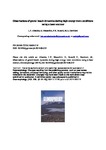Observations of gravel beach dynamics during high energy wave conditions using a laser scanner
| dc.contributor.author | Almeida, LP | |
| dc.contributor.author | Masselink, Gerd | |
| dc.contributor.author | Russell, Paul | |
| dc.contributor.author | Mikhalenko, Natalia | |
| dc.date.accessioned | 2014-09-24T08:20:11Z | |
| dc.date.available | 2014-09-24T08:20:11Z | |
| dc.date.issued | 2015-01-01 | |
| dc.identifier.issn | 0169-555X | |
| dc.identifier.issn | 1872-695X | |
| dc.identifier.uri | http://hdl.handle.net/10026.1/3122 | |
| dc.description | The work described in this publication was supported by the EPSRC project ARCoES — Adaptation and Resilience of the UK Energy System to Climate Change (EPSRC reference: EP/1035390/1) and by EPSRC grant EP/H040056/1 in partnership with the Channel Coastal Observatory (CCO). The full text is under embargo until 01.01.16. | |
| dc.description.abstract |
A 2D laser-scanner was deployed at the high tide runup limit of a pure gravel beach (Loe Bar, Cornwall, England) to measure high-frequency (2.5Hz) swash hydrodynamics and topographic changes during an energetic wave event. Measurements performed with the laser-scanner were corrected to compensate for levelling and orientation errors, and a variance threshold was applied to separate the beach topography from the water motions. Laser measurements were used to characterise the swash hydrodynamics and morphological changes during one tidal cycle through the calculation of several parameters, such as the 2% exceedence of the runup maxima (R2%), swash flow velocity skewness (<u3>), runup spectra and cumulative topographic changes. Results indicate that despite the small net morphological changes over the tide cycle, significant sediment mobilization occurs. A clear asymmetrical morphological response was found during the different tidal phases: the rising tide is dominated by accretion whilst the falling tide is dominated by erosion. The main factor controlling this asymmetrical morphological response is the step migration that, depending on the tide phase, controls the wave breaking point and consequently the dominant sediment transport direction. During the rising tide, step development decreases the shoreface slope and reduces the runup energy, whilst during the falling tide the step remobilization increases the shoreface slope and energy on the runup. | |
| dc.format.extent | 15-27 | |
| dc.language | en | |
| dc.language.iso | en | |
| dc.publisher | Elsevier BV | |
| dc.subject | Swash zone | |
| dc.subject | Remote sensing | |
| dc.subject | Bed evolution | |
| dc.subject | Hydrodynamics | |
| dc.subject | Gravel beaches | |
| dc.title | Observations of gravel beach dynamics during high energy wave conditions using a laser scanner | |
| dc.type | journal-article | |
| dc.type | Article | |
| plymouth.author-url | https://www.webofscience.com/api/gateway?GWVersion=2&SrcApp=PARTNER_APP&SrcAuth=LinksAMR&KeyUT=WOS:000347576300002&DestLinkType=FullRecord&DestApp=ALL_WOS&UsrCustomerID=11bb513d99f797142bcfeffcc58ea008 | |
| plymouth.issue | 1 | |
| plymouth.volume | 228 | |
| plymouth.publication-status | Published | |
| plymouth.journal | Geomorphology | |
| dc.identifier.doi | 10.1016/j.geomorph.2014.08.019 | |
| plymouth.organisational-group | /Plymouth | |
| plymouth.organisational-group | /Plymouth/Admin Group - REF | |
| plymouth.organisational-group | /Plymouth/Admin Group - REF/REF Admin Group - FoSE | |
| plymouth.organisational-group | /Plymouth/Faculty of Science and Engineering | |
| plymouth.organisational-group | /Plymouth/Faculty of Science and Engineering/School of Biological and Marine Sciences | |
| plymouth.organisational-group | /Plymouth/REF 2021 Researchers by UoA | |
| plymouth.organisational-group | /Plymouth/REF 2021 Researchers by UoA/UoA07 Earth Systems and Environmental Sciences | |
| plymouth.organisational-group | /Plymouth/Research Groups | |
| plymouth.organisational-group | /Plymouth/Research Groups/Marine Institute | |
| plymouth.organisational-group | /Plymouth/Users by role | |
| plymouth.organisational-group | /Plymouth/Users by role/Academics | |
| plymouth.organisational-group | /Plymouth/Users by role/Researchers in ResearchFish submission | |
| dc.identifier.eissn | 1872-695X | |
| dc.rights.embargoperiod | Not known | |
| rioxxterms.funder | Engineering and Physical Sciences Research Council | |
| rioxxterms.identifier.project | Adaptation and Resilience of Coastal Energy Supply | |
| rioxxterms.versionofrecord | 10.1016/j.geomorph.2014.08.019 | |
| rioxxterms.licenseref.uri | http://www.rioxx.net/licenses/all-rights-reserved | |
| rioxxterms.type | Journal Article/Review | |
| plymouth.funder | Adaptation and Resilience of Coastal Energy Supply::Engineering and Physical Sciences Research Council | |
| plymouth.funder | Adaptation and Resilience of Coastal Energy Supply::Engineering and Physical Sciences Research Council |


